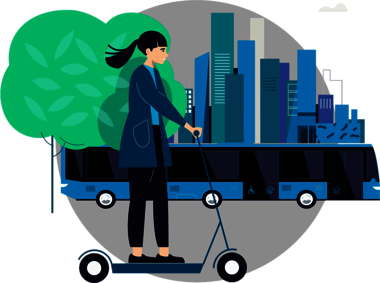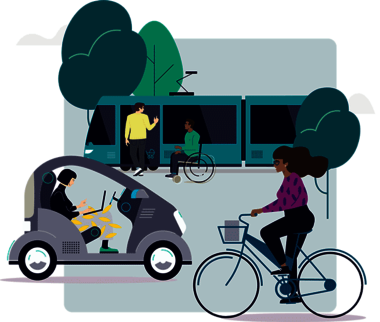Sustainable Mobility in Rural Areas
How to Achieve the Transition with MaaS and DRT
Teresa Gehling (Padam Mobility), Svenja Katharina Weiß (Hacon)
In rural areas, the state of affairs bemoaned by the German public transport company BVG in its song “Wir fahren allein allein” (“We ride alone alone”) tends to be the rule rather than an exception due to the pandemic. Public transport is virtually irrelevant in terms of everyday use in these regions, accounting for just 5% of journeys, compared with 70% for private car trips.

Alternatives to the car – non-existent?
In sparsely populated areas in particular, public transport is virtually impossible to run economically to fixed timetables and routes. This makes the transport offering sparse too: Just 19% of rural dwellers have a stop with at least one departure an hour in each direction (between 6 am and 8 pm on working days) within a radius of 250 meters from their village or hamlet as the crow flies.[ii] That said, the attraction of public transport in rural areas is not just severely diminished by the distance to the nearest stop and service frequency, but also by factors such as unreliable and inconvenient connecting services, neglected infrastructure at stops and complex fare structures. There is room for improvement on many counts, which is why public transport in general is not considered a comparable alternative to using a car of one’s own. Micromobility, car-sharing services and the like are generally not an option in rural areas for economic reasons. Cycle paths often run on or alongside roads and safe footpaths between settlements are not always available. People become reliant on their own cars for want of practical alternatives.

Consequences of the reliance on the private car
Among other things, the high proportion of motorized private transport on rural roads has a negative impact on CO2 emissions, air pollution and soil sealing. What’s more, commuter flows between rural and urban areas contribute to gridlock on key routes. In addition to the direct impact of the increased use of private cars, the reliance on this mode of transport is a particular cause for concern: Transport options for young and old people without a driver’s license, those on extremely low incomes or, to some extent, those with disabilities are extremely limited as a result, with these individuals often having to rely on the help of others. This is a problem of social equality, as well as a factor that makes rural areas less attractive and may contribute to a further exodus from these regions. So, how can mobility services be improved in rural areas?
Flexible on-demand services to supplement transport based on fixed timetables and routes
Demand-driven offerings allow services to run at times and in regions where take-up is low, thereby reducing gaps in mobility. The solutions available to date, such as dial-a-ride bus and hailed shared taxi services, are generally timetable-based, needing to be booked some 30 to 60 minutes before departure. In many cases, this is impracticable and does not give passengers the feeling of being sufficiently flexible and in control.
Modern on-demand concepts, by contrast, enable the establishment of an almost tailored transportation offering. Users can book their own trip at a time of their choosing via an app or website or by phone. Depending on the model, the service is not restricted to fixed routes, but can operate freely within defined zones, combining physical and virtual stops. Unlike taxi services, for instance, on-demand services are geared toward combining individual rides in dynamic fashion. Intelligent algorithms ensure efficient route planning: the service only stops at places where passengers wish to get on or off. Thus, passengers have to put up with only minimal detours, while empty trips are reduced significantly too.
Comprehensive mobility offerings: MaaS apps with on-demand integration
On-demand transport in rural areas makes sense not only for travel between settlements, but also as connecting services, such as shuttles to and from train stations with rail links to nearby metropolitan areas. Intermodal travel of this kind must be able to be planned and booked in straightforward, reliable fashion: Passengers do not want to have to consult three separate timetables to discover when their train leaves, which connecting bus they can take at their destination and when an on-demand shuttle is available for the first mile of their journey. As well as being highly inconvenient, this increases the risk of miscalculating connecting times. What’s more, calculating the fare can be difficult, especially when traveling beyond regional transportation boundaries. The acceptance of on-demand offerings, and of public transport in general, will be greatly improved if these offerings are deeply integrated in MaaS apps and users are able to pay for all the modes of transport required for their journey in a single process, using just one app and account. Even greater flexibility is created with the integration of additional offerings, such as car-sharing services in small towns nearby.
Because of the much more extensive and extremely wide-ranging mobility offering in big cities, Mobility-as-a-Service is frequently regarded as a purely urban concept. That said, the effective orchestration of existing services is particularly important in regions with a limited transport offering. Moreover, areas where there may be a demand for mobility but as yet no related service can be identified through the systematic analysis of aggregated travel connection requests. These gaps in supply may, in turn, motivate new mobility providers to operate services in rural areas, thereby triggering an ongoing process of development that enhances quality of life and helps to make a success of the mobility transition in the countryside too. Mobility is a fundamental need that must be made accessible to all. The introduction of MaaS concepts featuring on-demand components not only helps to create a comprehensive mobility solution tailored to customer requirements that does not involve car ownership, but can also help to make public transport more attractive and eco-efficient overall.

